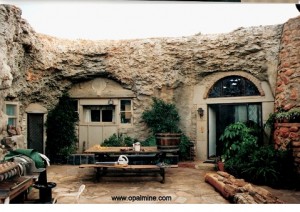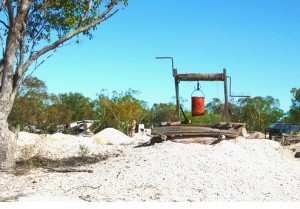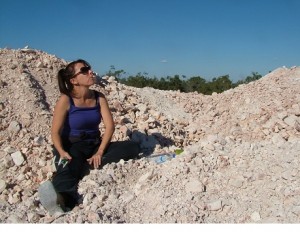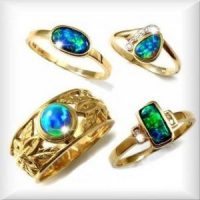Opal Mines of Australia
Opal mines of Australia were discovered back in the mid-nineteenth century. Often they were discovered by chance while various outback men were going about duties far removed from the idea of looking for precious gems, in this case, opal. Since this article was written, Mike cleaned out this hole but in typical Lightning Ridge fashion, the hole was dry of opal, so he had to start again somewhere else.

| Mike and Max (visiting from Germany) Lightning Ridge |
Queensland Opal Mines
There are many stories about how opal mines were first worked but one that seems pretty accurate is that it was first begun by a geologist from Germany by the name of Johannes Menge who apparently found common opal of a green color at Angaston in South Australia.
In 1868, at Listowel Downs near Blackall in Western Queensland, opal was found in thin veins inside large ironstone boulders. Hence the name ‘Boulder opal’ Later, in 1871 the first lease allowing digging to be done was recorded in the Quilpie area.
I first caught sight of Boulder opal at Quilpie in the shop of a local chemist, Des Burton, who gradually gave up a medical practice in favor of opal mining. Des, who has now passed away, became one of the biggest boulder opal miners in Australia.
He was a kind man who gave work to a lot of guys who had problems with alcohol and the hard work often kept them off the grog. Des’ company is still mining and is being administered by his son.
Mining Opals is one of those pastimes that is not for the faint-hearted or the city dweller who enjoys all of life’s comforts. It’s often associated with heat, flies, and hard work, but the rewards are really amazing.
Some opal miners say that, when their mine produces precious opal, it makes their heart skip a beat and the feeling is far superior to other life’s pleasures. Boulder Opals are fast becoming the opal in demand because of there amazing varieties and prices to suit every pocket.

Opal Mines at White Cliffs
The first commercially viable opal field was discovered at White Cliffs in NSW in 1894. This field produced large volumes of crystal opal and if you look at a picture of these opal mines from the air, you are really amazed at the amount of work that has been put into this field.
The surface looks like the craters of the moon and all of the digging was done until recently with a pic and shovel and a hand driven windlass.
White cliffs opal mining ended about the time the First World War began in 1914. It was not until the mid-seventies that other opal miners brought Caldwell drill equipment from Coober Pedy, that a brief new field started with some excellent finds.
Opal Mines at Coober Pedy

When White Cliffs closed down, opal mines were found in other places. Opal digging shifted states to South Australia when a young boy by the name of Willie Hutchinson discovered a piece of opal on top of the ground in a place later called ‘Coober Pedy’ which is an aboriginal name meaning ‘white man in a hole.’
This opal field became the capital of opal in the world being the largest field ever discovered. Opal mining in Coober Pedy continues to this day, although some say it’s starting to run out.
Opals mines at Mintabie and Lambina
Later, north of Coober Pedy toward Alice Springs, central Australia, the opal mines of Mintabie was discovered and became a major field in itself. Mintabie opal was often very dark, similar to Lightning Ridge and some say the color was as good. Another field called ‘Lambina’ was also discovered to the east of Mintabie which also produced some magnificent opal.
Other Opal mines in Queensland
In the meantime, the boulder opal mines in Queensland continued to expand and opal was discovered as far north as Opalton, down through Winton, then to Blackall, then Quilpie region where lots of other opal mines were producing including Jundah, Eromanga, Bull Creek, to name a few.
Very important to mention as well are the smaller opal fields down near the NSW border, Yowah, Black Gate, and further east toward Cunnamulla, the Koroit opal mines.
Opal mines at Lightning Ridge
One of the last remaining miner’s huts in the main street of Lightning Ridge with a parcel of black opal
Opal Mines of Australia took on a different aspect when Lightning Ridge opal field was discovered. These Opal Mines really stand out from the others because of the discovery of what came to be known as black opal, the prince of all opals. That was reportedly in 1873 when the manager of Muggarie Station (later Angledool station) discovered the stone while prospecting in the Nebea area.
In 1887 more opal was found in a gravel pit, nine miles from the town. In 1890 a rabbit trapper named Jack Murray found opal when setting a trap. Since then, the rest is history. Many opal mines have been found in this area. Sheepyards, Grawin, Corcoran, and heaps of other opal mines in the direct area of Lightning Ridge.
Tourism at the opal mines of Australia
 Many tourists make their way to these outback opal mines today. Folks from all over the world, particularly Europeans from Germany, France, Spain. Americans and Englishmen and women are fascinated with these opal fields so far from civilization. Some never go home again. The town of Lightning Ridge must have around 50 different cultures and languages including aboriginals who are probably some of the most successful opal miners. So the opal mines of Australia, whether they be in Queensland, South Australia, NSW, or anywhere else, are fascinating places to visit whether you are actually mining opals yourself, or just fossicking and visiting. If you do want to get into the excitement of this lovely stone, keep in mind that you can buy rough opal from sites like this, learn how to cut and polish it, and set it into jewelry. Please leave your details on this site if you want to know more about this, or if not, make some comments below for the benefit of all readers. At opalmine.com you are sure to find opals and believe me, it’s cheaper to spend a few dollars on rough opal than try to dig for them. Paper picks are far more effective than the steel variety if you know what I mean. But you will find much more at opals.co. You can bury your head in the opal encyclopedia. You can tour the Australian outback. You can obtain your own collection of opal books. You can become an opal expert yourself with the CD ‘OPAL BLOKE’ which records 30 years of opal experience from the author, Peter Brusaschi. and if that’s not enough you can as questions about opal and talk to your opal friends from all over the world in the opalmine chat forum. A visit to opals.co is a smooth ride. You don’t need a 4WD. You don’t even need a car or a pushbike. just click on opalmine.com and enjoy the experience. |
Best wishes from the land down under. The home of Kangaroos, Crocodiles, Emus, Aussie rules football, and Opal mines







I would like to learn more as o will be going to blackall in a couple week to mine just bye my self im a 25 year old aus trying to find the opal rush if someone could let me know on What the prOCes is on getting a perm and how much and where would the best place to start
Joshua, just go to the pink HELP button on this site and leave a message there with your mobile number. ill give you a ring and offer you some advice. Hope your plans go well. peter
After I originally commented I appear to have
clicked on the -Notify me when new comments are added- checkbox and now
every time a comment is added I get 4 emails with the exact same comment.
Perhaps there is an easy method you can remove me from that service?
Appreciate it!
Sorry about this Nicol. I will as the site manager to check on it. peter
Name: nicolialia pizzeria
I would like to learn more!
Colleen did you see our opal videos on the site? take a look down the bottom of this page. and here